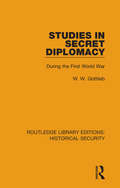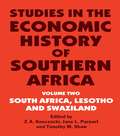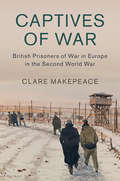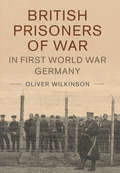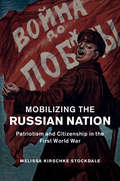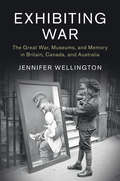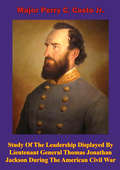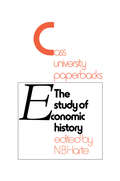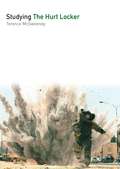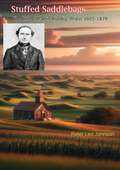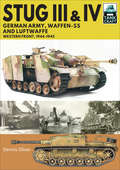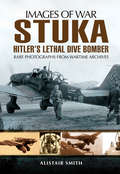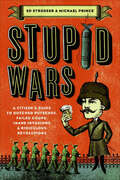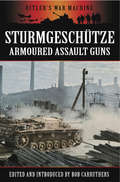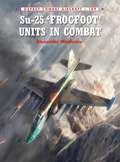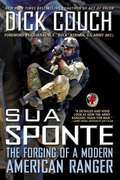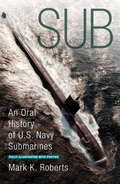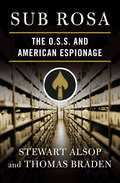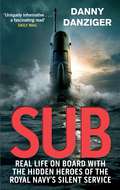- Table View
- List View
Studies in Secret Diplomacy: During the First World War (Routledge Libary Editions: Historical Security)
by W. W. GottliebOriginally published in 1957, the original blurb reads: ‘From these studies of the secret diplomacy surrounding the entry of Turkey and Italy into the First World War, emerges a picture of the complex machinery behind the obvious wheels of international politics. The activities of statesmen and diplomats are related to the ramifications of big business, banks, oil and armament companies. The story of each move and counter-move, told mostly in the actors’ own words and with many quotations from actual memoranda and dispatches, is based on sources which are quite new. The Russian collections of confidential correspondence, which include foreign diplomatic dispatches intercepted and deciphered in Russia, and the latest Documenti Diplomatici Italiani are practically unknown to the British public. This material has been integrated with that taken from all the available collections of British, French, German, Austro-Hungarian and American diplomatic documents, official publications, contemporary periodicals and economic and financial data, and such mines of information as the diaries, recollections and private letters of those involved. This unusual combination of source material allows some general conclusions to be drawn as to the laws and logic of the diplomacy of power politics. The most striking fact, perhaps, is the diplomatic war among allies. The book brings out the deep-seated conflicts of interests in the German-Austro-Hungarian coalition, and those dividing Britain, France, Russia and Italy in the Near East, the Balkans and the Mediterranean. Another point of special interest is the inter-group and party struggle inside the countries for or against war; and another is the genesis of some of the fateful Secret Treaties which bedevilled the peace settlements of 1919-20.’ Today it can be read and enjoyed in its historical context.
Studies in the Economic History of Southern Africa: Volume Two : South Africa, Lesotho and Swaziland
by Timothy M. Shaw Jane L. Parpart Z.A. KonczackiFirst Published in 1990. Volume Two of Studies of Economic History of South Africa, looks at the Lesotho and Swaziland regions. The unfolding history and historiography of Southern Africa pose profound challenges for both analysis and praxis in the last decade of the twentieth century. These challenges are reflected in the range of investigations and contradictions, some of which are treated here, which together constitute an intellectual and political conjuncture. This collection of studies deals with the countries which were not included in the companion book on the economic history of the Front- Line States. Most of the space in the present volume is devoted to South Africa, primarily because of its importance to the region but also because contributions to the economic history of that country in English are very extensive as compared to the other states of Southern Africa.
Studies in the Social and Cultural History of Modern Warfare: Allies in Memory
by Sam EdwardsAmidst the ruins of postwar Europe, and just as the Cold War dawned, many new memorials were dedicated to those Americans who had fought and fallen for freedom. Some of these monuments, plaques, stained-glass windows and other commemorative signposts were established by agents of the US government, partly in the service of transatlantic diplomacy; some were built by American veterans' groups mourning lost comrades; and some were provided by grateful and grieving European communities. As the war receded, Europe also became the site for other forms of American commemoration: from the sombre and solemn battlefield pilgrimages of veterans, to the political theatre of Presidents, to the production and consumption of commemorative souvenirs. With a specific focus on processes and practices in two distinct regions of Europe – Normandy and East Anglia – Sam Edwards tells a story of postwar Euro-American cultural contact, and of the acts of transatlantic commemoration that this bequeathed.
Studies in the Social and Cultural History of Modern Warfare: British Art and the First World War, 1914–1924
by James FoxThe First World War is usually believed to have had a catastrophic effect on British art, killing artists and movements, and creating a mood of belligerent philistinism around the nation. In this book, however, James Fox paints a very different picture of artistic life in wartime Britain. Drawing on a wide range of sources, he examines the cultural activities of largely forgotten individuals and institutions, as well as the press and the government, in order to shed new light on art's unusual role in a nation at war. He argues that the conflict's artistic consequences, though initially disruptive, were ultimately and enduringly productive. He reveals how the war effort helped forge a much closer relationship between the British public and their art - a relationship that informed the country's cultural agenda well into the 1920s.
Studies in the Social and Cultural History of Modern Warfare: British Prisoners of War in Europe in the Second World War (Studies in the Social and Cultural History of Modern Warfare #51)
by Clare MakepeaceThis is a pioneering history of the experience of captivity of British prisoners of war in Europe during the Second World War, focussing on how they coped and came to terms with wartime imprisonment. Clare Makepeace reveals the ways in which POWs psychologically responded to surrender, the camaraderie and individualism that dominated life in the camps, and how, in their imagination, they constantly breached the barbed wire perimeter to be with their loved ones at home. Through the diaries, letters and log books written by seventy-five POWs, along with psychiatric research and reports, she explores the mental strains that tore through POWs' minds and the challenges that they faced upon homecoming. The book tells the story of wartime imprisonment through the love, fears, fantasies, loneliness, frustration and guilt that these men felt, shedding new light on what the experience of captivity meant for these men both during the war and after their liberation.
Studies in the Social and Cultural History of Modern Warfare: British Prisoners of War in First World War Germany (Studies in the Social and Cultural History of Modern Warfare #49)
by Oliver WilkinsonOver 185,000 British military servicemen were captured by the Germans during the First World War and incarcerated as prisoners of war (POWs). In this original investigation into their experiences of captivity, Wilkinson uses official and private British source material to explore how these servicemen were challenged by, and responded to, their wartime fate. Examining the psychological anguish associated with captivity, and physical trials, such as the controlling camp spaces; harsh routines and regimes; the lack of material necessities; and, for many, forced labour demands, he asks if, how and with what effects British POWs were able to respond to such challenges. The culmination of this research reveals a range of coping strategies embracing resistance; leadership and organisation; networks of support; and links with 'home worlds'. British Prisoners of War offers an original insight into First World War captivity, the German POW camps, and the mentalities and perceptions of the British servicemen held within.
Studies in the Social and Cultural History of Modern Warfare: Memory and Migration in the Shadow of War
by Joy DamousiIn an engaging and original contribution to the field of memory studies, Joy Damousi considers the enduring impact of war on family memory in the Greek diaspora. Focusing on Australia's Greek immigrants in the aftermath of the Second World War and the Greek Civil War, the book explores the concept of remembrance within the larger context of migration to show how intergenerational experience of war and trauma transcend both place and nation. Drawing from the most recent research in memory, trauma and transnationalism, Memory and Migration in the Shadow of War deals with the continuities and discontinuities of war stories, assimilation in modern Australia, politics and activism, child migration and memories of mothers and children in war. Damousi sheds new light on aspects of forgotten memory and silence within families and communities, and in particular the ways in which past experience of violence and tragedy is both negotiated and processed.
Studies in the Social and Cultural History of Modern Warfare: Ordinary Workers, Vichy and the Holocaust
by Ludivine BrochShould French railwaymen during the Second World War be viewed as great resisters or collaborators in genocide? Ludivine Broch revisits histories of resistance, collaboration and deportation in Vichy France through the prism of the French railwaymen – the cheminots. De-sanctifying the idea of railwaymen as heroic saboteurs, Broch reveals the daily life of these workers who accommodated with the Vichy regime, cohabitated with the Germans and stole from their employer. Moreover, by intertwining the history of the working classes with Holocaust history, she highlights unexpected histories under Vichy and sensitive memories of the post-war period. Ultimately, this book bursts the myths of cheminot resistance and collaboration in the Holocaust, and reveals that there is more to their story than this. The cheminots fed both the French nation and the German military apparatus, exemplifying the complexities of personal, professional and political life under occupation.
Studies in the Social and Cultural History of Modern Warfare: Patriotism and Citizenship in the First World War
by Stockdale Melissa KirschkeThe First World War had a devastating impact on the Russian state, yet relatively little is known about the ways in which ordinary Russians experienced and viewed this conflict. Melissa Kirschke Stockdale presents the first comprehensive study of the Great War's influence on Russian notions of national identity and citizenship. Drawing on a vast array of sources, the book examines the patriotic and nationalist organizations which emerged during the war, the role of the Russian Orthodox Church, the press and the intelligentsia in mobilizing Russian society, the war's impact on the rights of citizens, and the new, democratized ideas of Russian nationhood which emerged both as a result of the war and of the 1917 revolution. Russia's war experience is revealed as a process that helped consolidate in the Russian population a sense of membership in a great national community, rather than being a test of patriotism which they failed.
Studies in the Social and Cultural History of Modern Warfare: Shell-Shock and Medical Culture in First World War Britain
by Tracey LoughranShell-Shock and Medical Culture in First World War Britain is a thought-provoking reassessment of medical responses to war-related psychological breakdown in the early twentieth century. Dr Loughran places shell-shock within the historical context of British psychological medicine to examine the intellectual resources doctors drew on as they struggled to make sense of nervous collapse. She reveals how medical approaches to shell-shock were formulated within an evolutionary framework which viewed mental breakdown as regression to a level characteristic of earlier stages of individual or racial development, but also ultimately resulted in greater understanding and acceptance of psychoanalytic approaches to human mind and behaviour. Through its demonstration of the crucial importance of concepts of mind-body relations, gender, willpower and instinct to the diagnosis of shell-shock, this book locates the disorder within a series of debates on human identity dating back to the Darwinian revolution and extending far beyond the medical sphere.
Studies in the Social and Cultural History of Modern Warfare: The First World War and German National Identity
by Jan VermeirenThe First World War and German National Identity is an original and carefully researched study of the coalition between Imperial Germany and Austria-Hungary during the First World War. Focusing on the attitudes taken by governmental circles, politically active groups, intellectuals, and the broader public towards the German-speaking population in the Habsburg Monarchy, Jan Vermeiren explores how the war challenged established notions of German national identity and history. In this context, he also sheds new light on key issues in the military and the diplomatic relationship between Berlin and Vienna, re-examining the German war aims debate and presenting many new insights into German-Hungarian and German-Slav relations in the period. The book is a major contribution to German and Central European history and will be of great interest to scholars of the First World War and the complex relationship between war and society.
Studies in the Social and Cultural History of Modern Warfare: The Great War, Museums, and Memory in Britain, Canada, and Australia (Studies in the Social and Cultural History of Modern Warfare #53)
by Jennifer WellingtonWhat does it mean to display war? Examining a range of different exhibitions in Britain, Canada and Australia, Jennifer Wellington reveals complex imperial dynamics in the ways these countries developed diverging understandings of the First World War, despite their cultural, political and institutional similarities. While in Britain a popular narrative developed of the conflict as a tragic rupture with the past, Australia and Canada came to see it as engendering national birth through violence. Narratives of the war's meaning were deliberately constructed by individuals and groups pursuing specific agendas: to win the war and immortalise it at the same time. Drawing on a range of documentary and visual material, this book analyses how narratives of mass violence changed over time. Emphasising the contingent development of national and imperial war museums, it illuminates the way they acted as spaces in which official, academic and popular representations of this violent past intersect.
Study Of The Leadership Displayed By Lieutenant General Thomas Jonathan Jackson During The American Civil War
by Major Perry C. Casto Jr.Confederate Lieutenant General Thomas J. Jackson is considered one of the greatest tacticians who ever lived. His Valley Campaign of 1862 is a classic example of the effective use of maneuver warfare. While much has been written about Jackson's tactics, very little attention has been paid to his leadership of the soldiers who executed his tactical plans. The United States Army's recent emphasis on maneuver warfare has stressed the importance of leadership in the conduct of such warfare. This study is an analysis of Jackson's military leadership as he commanded units from brigade to corps level in the Confederate Army of Northern Virginia to determine if he met the requirements of a good leader as those requirements are defined by current US Army doctrine. The study uses current Army doctrine as the basis to judge the effectiveness of Jackson as a leader. It discusses Jackson's background and its effect on the character of his leadership, the leadership that he displayed during the Civil War, and then compares his actions to current doctrine. The study concludes that while some of Jackson's actions deviated significantly from today's doctrinally sound leadership practices, in the aggregate his leadership was congruous with current doctrine and contributed to his success as a field commander.
Study of Economic History: Collected Inaugural Lectures 1893-1970
by N. B. HartePublished in the year 1975, Study of Economic History is a valuable contribution to the field of Military and Strategic Studies.
Studying The Hurt Locker (Studying Films)
by Terence McSweeneyIn this vibrant and dynamic book-length study drawing on a broad tapestry of research, Terence McSweeney offers an exploration of The Hurt Locker (2009), its stylistic and narrative devices, its cultural impact, its reception, and its relationship to the genre of the war film. McSweeney places the film in a richly textured historical, political, and industrial context, arguing that The Hurt Locker is part of a long tradition of films about American wars that play a considerable role in how audiences come to understand the conflicts that they depict. Thus, films about a nation’s wars are never “only a movie” but rather should be considered a cultural battleground themselves on which a war of representation is waged.
Stuffed Saddlebags: The Life of Martin Kundig, Priest 1805-1879
by Peter Leo JohnsonStuffed Saddlebags: The Life of Martin Kundig, Priest 1805-1879 is a biographical book written by Peter Leo Johnson. The book is a detailed account of the life of Martin Kundig, a Swiss Catholic priest who lived from 1805 to 1879. Kundig was a prominent figure in the Catholic Church and played a significant role in the religious and social history of Switzerland. The book provides a comprehensive overview of Kundig's life, from his childhood in Switzerland to his religious training and eventual ordination as a priest. The author delves into Kundig's experiences as a missionary in the United States and his work in establishing Catholic parishes and schools in the American Midwest. The book also explores Kundig's involvement in the political and social issues of his time, including his support for the abolition of slavery and his advocacy for the rights of immigrants. The author provides a detailed analysis of Kundig's writings and sermons, which reflect his commitment to social justice and his belief in the importance of education. Overall, Stuffed Saddlebags is a fascinating and insightful biography of a remarkable individual who played a significant role in the history of the Catholic Church and the United States. The book is well-researched and provides a rich and detailed portrait of Kundig's life, beliefs, and achievements. It is an excellent read for anyone interested in the history of the Catholic Church, American social history, or the life of a remarkable individual.-Print ed.
Stug III & Stug IV: German Army, Waffen-SS and Luftwaffe: Western Front, 1944–1945 (TankCraft)
by Dennis OliverA guide that blends the history behind this German World War II tank with resources for military vehicle modeling enthusiasts. In the last years of the Second World War the Sturmgeschütz III (StuG III) and Sturmgeschütz IV (StuG IV) played a vital role as assault guns during the German army&’s struggle to block the Allied advance on the Western Front. As the Wehrmacht&’s tank forces declined, these armored vehicles were thrown into every defensive operation. They are not as well-known as the Tigers and Panthers, but German resistance would have been much weaker without them. They were also among the most frequently encountered German armored vehicles on the battlefields, which is why they are such a fascinating subject for Dennis Oliver in this volume in the TankCraft series He uses archive photos and extensively researched color illustrations to examine the StuG III and StuG IV deployed by the German army and the Waffen-SS during these doomed campaigns. A key section of his book displays available model kits and aftermarket products, complemented by a gallery of beautifully constructed and painted models in various scales. Technical details as well as modifications introduced during production and in the field are also examined providing everything the modeler needs to recreate an accurate representation of these historic armored vehicles.
Stuka: Hitler's Lethal Dive Bomber (Images of War)
by Alistair Smith&“A very nice release about the most recognizable German aircraft of the Second World War&” from the author of Rommel&’s Army in the Desert (Inscale.org). The photographs in this collection belonged to Luftwaffe Stuka rear gunner and radio operator Erich Heine. The collection includes photographs of flights of Stukas in formation, operating training aircraft, and a selection of different Luftwaffe uniforms and flight gear. The photographer was based for a period in Czechoslovakia, was shot down over the Ukraine in August 1943 and for a time was listed as missing in action. This collection offers a unique insight into the German experience of World War Two, providing the opportunity to access materials that have never been published before&“The book very ably documents the war career of the aircraft and the pilots, reproducing some outstanding images of war.&” —Firetrench&“The most remarkable thing about this album is that it contains photographs of perhaps the most famous Stuka ace, Hans-Ulrich Rudel.&” —Inscale.org&“The photographs . . . show the life of Erich and Luftwaffe Stuka crew members through training/deployment/leave and include funerals of squadron members . . . The narrative gives a good overview of the Stuka in service and the photographs show varied views of the aircraft and day to day life within the squadron.&” —WW2 Talk
Stupid Wars: A Citizen's Guide to Botched Putsches, Failed Coups, Inane Invasions & Ridiculous Revolutions
by Ed Strosser Michael PrinceWhen winners write history, they sometimes "forget" to include their own embarrassing misjudgments. Fortunately, this take-no-prisoners edition of history isn't going to let the winners (or the losers) forget the mistakes of the past. Be prepared to laugh out loud—and gasp in horror—at the most painfully idiotic strategies, alliances, and decisions the world has ever known. These stupid wars have been launched by democracies as well as monarchies and dictatorships, in recent decades just as often as in less "enlightened" times. The ridiculous and reckless conflicts chronicled in Stupid Wars include the misdirected Fourth Crusade, the half-baked invasion of Russia by the U.S., the U.K.'s baffling Falklands War, Hitler's ill-fated Beer Hall Putsch, several incredibly foolish South American conflicts, the Bay of Pigs fiasco, and many more. Whether you're a future dictator, war-mongering politician, royal mistress, or history lover, these blow-by-stupid-blow accounts will teach you the valuable lessons you need to stay off the list, including: Don't declare war on all your neighbors at the same time.Working radios, accurate maps, and weather-appropriate uniforms are big plusses.Large amounts of bird poop and very small islands are probably not worth dying for.Never invade Russia. Seriously. It's a really bad idea.
Sturmgeschütze: Armoured Assault Guns (Hitler's War Machine)
by Bob CarruthersAn overview of the Wehrmacht&’s little-known mobile assault guns designed to provide close infantry support against enemy field defenses in World War II. The Stürmgeschutze rumbling forward into action is one of the iconic images of World War II. As mobile assault guns, the StuGs were essentially designed as infantry support weapons, but they also proved themselves as highly effective tank destroyers. Written by Emmy Award-winning author Bob Carruthers this fascinating study encompasses the design, development and combat history of the StuG II and IV. Drawing on a variety of rare primary sources and photographs this outstanding study explains the role of the StuG in context and examines the combat records of the StuG aces such as Franz von Malachowski, and Knight&’s Cross holder Oberwachtmeister Hugo Primozic of Stug.Abt.667. Indispensable reading for anyone with an interest in armored warfare, this book is part of the Hitler&’s War Machine series, a new military history range compiled and edited by Emmy Award winning-author and historian Bob Carruthers. The series draws on primary sources and contemporary documents to provide a new insight into the true nature of Hitler&’s Wehrmacht.
Su-25 'Frogfoot' Units In Combat
by Alexander Miladenov Rolando UgoliniUncover the technical features and operational performance of the Soviet Su-25 'Frogfoot', which proved itself as a durable and versatile attack aircraft in a variety of theaters in the middle East. Had the Cold War developed into a more serious conflict, the Su-25 would have been the main Soviet combat type facing US aircraft.Today it is widely accepted as the true successor to the types of specialized ground--attack aircraft that emerged during World War II. The book details the service history of the 'Frogfoot' during more than 30 years of combat using first-hand accounts and revealing archive photographs. The Su-25 has often been underrated, but the faithful 'Frogfoot' is now slated to remain in service with most of its current operators across the globe until at least 2020. This study explores the successes of the Su-25 in full, demonstrating its' strengths as a formidably armed, armored and very agile attack aircraft.
Sua Sponte
by Dick CouchSua Sponte Latin for "Of Their Own Accord" The 75th Ranger Regiment's Motto Army Rangers are not born. They are made. The modern 75th Ranger Regiment represents the culmination of 250 years of American soldiering. As a fighting force with our nation's oldest and deepest tradition, the Regiment traces its origins to Richard Rogers's Rangers during the prerevolutionary French and Indian War, through the likes of Francis Marion and John Mosby, to the five active Ranger battalions of the Second World War, and finally, to the four battalions of the current Ranger regiment engaged in modern combat. Granted unprecedented access to the training of this highly restricted component of America's Special Operations Forces in a time of war, retired Navy captain Dick Couch tells the personal story of the young men who begin this difficult and dangerous journey to become Rangers. Many will try, but only a select few will survive to serve in the 75th Ranger Regiment. Sua Sponte follows a group of these aspiring young warriors through the crucible that is Ranger training and their preparation for direct-action missions in Afghanistan against America's enemies, anywhere, any time, and under any conditions. INCLUDES PHOTOGRAPHS
Sub
by Mark RobertsTrue tales of life and death as told by those who fought in the briny depths. From the undersea warfare of World War II through the Cold War stand-offs in the deep to the cutting-edge technology of the modern U.S. Navy, submarines have evolved into the front line of our nation's defense at sea. And the men who sail them have become heroes above and below the waves. These are their stories. Compiled from interviews and recollections from submarine veterans and accompanied by detailed photos and illustrations of both man and machine at work, Sub is a gripping chronicle of undersea warfare as told by those who know firsthand what it means to drop through the hull of a boat, to sink into the dark, freezing waters of the deep-and to have death never more than one torpedo away.
Sub Rosa: The O. S. S. and American Espionage
by Stewart Alsop Thomas BradenA thrilling history of the Office of Strategic Services, America&’s precursor to the CIA, and its secret operations behind enemy lines during World War II. Born in the fires of the Second World War, the Office of Strategic Services, or OSS, was the brainchild of legendary US Maj. Gen. William &“Wild Bill&” Donovan, designed to provide covert aid to resistance fighters in European nations occupied by Germany&’s Nazi aggressors. Paratroopers Stewart Alsop and Thomas Braden—both of whom would become important political columnists in postwar years—became part of Wild Bill&’s able collection of soldiers, spies, and covert operatives. Sub Rosa is an enthralling insider&’s history of the remarkable intelligence operation that gave birth to the CIA. In Sub Rosa, Alsop and Braden take readers on a breathtaking journey through the birth and development of the top secret wartime espionage organization and detail many of the extraordinary OSS missions in France, Germany, Dakar and Casablanca in North Africa, and in the jungles of Burma that helped to hasten the end of the Japanese Empire and the fall of Adolf Hitler&’s powerful Reich. As exciting as any international thriller written by Eric Ambler or Graham Greene, Alsop and Braden&’s Sub Rosa is an indispensable addition to the literary history of American espionage and intelligence.
Sub: Real Life on Board with the Hidden Heroes of the Royal Navy's Silent Service
by Danny Danziger300 million cubic miles of ocean.Stealthy, and deadly, the nuclear submarines of the Royal Navy lie in wait in the depths of the world's oceans, ready to listen, intercept, and attack wherever they may be needed - from the coastline of Libya to the ice caps of the Arctic. If the UK is hit by a devastating nuclear strike, they'll be the last military force standing.200 million pounds of hardware.Award-winning journalist Danny Danziger has been allowed unprecedented access to the elite crew of one of the UK's attack class submarines, joining them on operations and hearing their stories. Unrestricted, and uncompromising, Sub paints a vivid picture of this fascinating, little-known branch of our armed forces.One incredible hunter-killer.In an increasingly unstable world, these are the people who keep us safe. It is time for the silent service to be heard.
